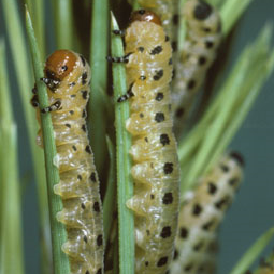Mother Nature was not the pine sawfly’s – a brown wasp whose larvae feast on ponderosa and other pine needles after hatching – friend last year. The hungry predator that severely defoliated thousands of acres of ponderosa pine in 2014 experienced a climatological impact on egg hatch in 2015. Cooler temperatures and heavy rains last spring resulted in what the Colorado State Forest Service refers to as “high larval mortality.”
However, some areas of the state are still seeing infestations. Franktown, Elizabeth and parts of Parker experienced an outbreak that reached  epidemic proportions last summer. Complete defoliation of trees was seen in affected areas. Defoliated trees are a fire hazard and should be addressed by property owners.
epidemic proportions last summer. Complete defoliation of trees was seen in affected areas. Defoliated trees are a fire hazard and should be addressed by property owners.
Sawflies lay their eggs in the fall during what’s known as their flight period, usually in September and October. An individual pine needle can host about 20 sawfly eggs. The eggs overwinter and if weather conditions are mild, virtually all of the eggs could hatch in late spring. Too many hatchlings could result in a starvation death for about half of the larvae, but thousands of hatchlings still survive.
The best time to address a sawfly infestation is when the eggs begin to hatch in June. But forewarned is forearmed. If an infestation of pines during and after the sawfly’s flight period in the fall is identified, treatment can be more effectively planned.
Both eggs and larvae can be handpicked off trees or washed off with a high-pressure hose. Severe infestations or infestations of high-value pines may need chemical treatment, which is often best left to professionals because of the precision required when choosing an insecticide.
Contact SprayTech, Colorado commercial and residential tree-spraying specialists, at 720-248-0000, for inspection of pine trees on your property and to discuss sawfly treatment options.
Comments are closed.